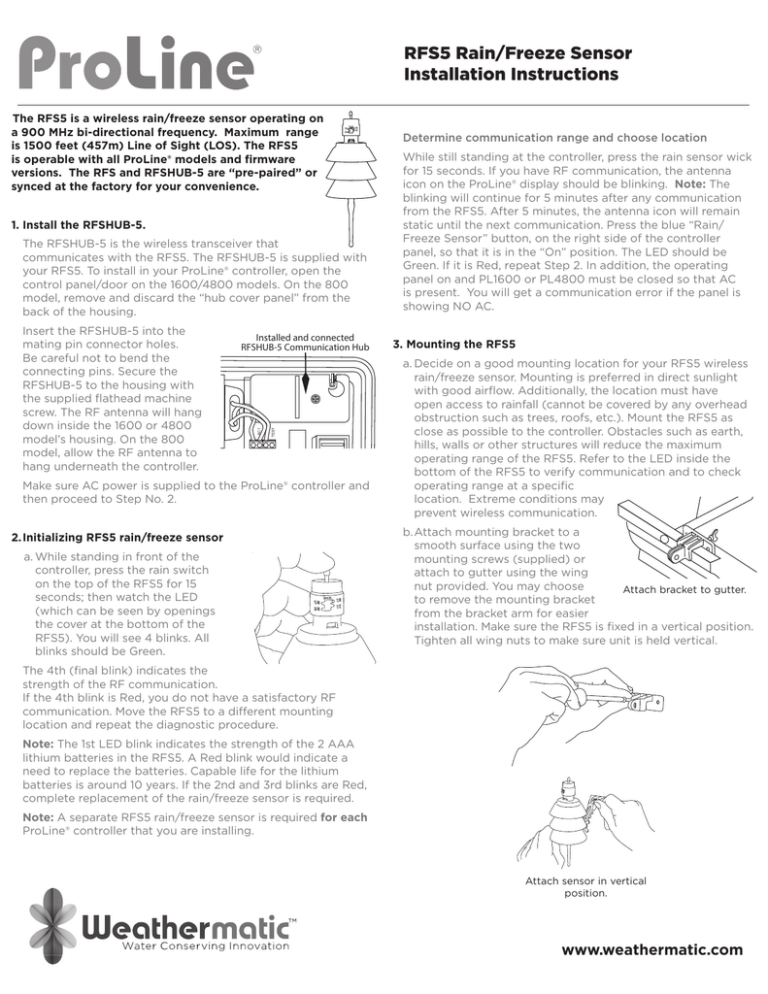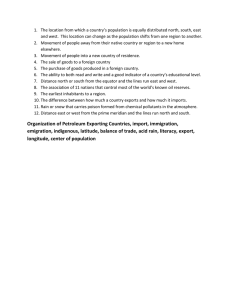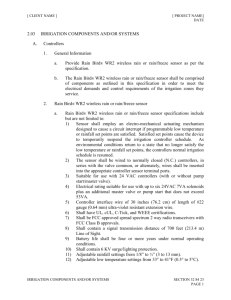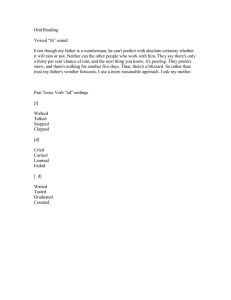Manual - Reece
advertisement

RFS5 Rain/Freeze Sensor Installation Instructions The RFS5 is a wireless rain/freeze sensor operating on a 900 MHz bi-directional frequency. Maximum range is 1500 feet (457m) Line of Sight (LOS). The RFS5 is operable with all ProLine® models and firmware versions. The RFS and RFSHUB-5 are “pre-paired” or synced at the factory for your convenience. 1/4 3/4 inch 1/8 1/2 1. Install the RFSHUB-5. The RFSHUB-5 is the wireless transceiver that communicates with the RFS5. The RFSHUB-5 is supplied with your RFS5. To install in your ProLine® controller, open the control panel/door on the 1600/4800 models. On the 800 model, remove and discard the “hub cover panel” from the back of the housing. SEN AC1 TEST Installed and connected RFSHUB-5 Communication Hub P/MV SEN COM Insert the RFSHUB-5 into the mating pin connector holes. Be careful not to bend the connecting pins. Secure the RFSHUB-5 to the housing with the supplied flathead machine screw. The RF antenna will hang down inside the 1600 or 4800 model’s housing. On the 800 model, allow the RF antenna to hang underneath the controller. Make sure AC power is supplied to the ProLine® controller and then proceed to Step No. 2. 2.Initializing RFS5 rain/freeze sensor a.While standing in front of the controller, press the rain switch on the top of the RFS5 for 15 seconds; then watch the LED (which can be seen by openings the cover at the bottom of the RFS5). You will see 4 blinks. All blinks should be Green. Determine communication range and choose location While still standing at the controller, press the rain sensor wick for 15 seconds. If you have RF communication, the antenna icon on the ProLine® display should be blinking. Note: The blinking will continue for 5 minutes after any communication from the RFS5. After 5 minutes, the antenna icon will remain static until the next communication. Press the blue “Rain/ Freeze Sensor” button, on the right side of the controller panel, so that it is in the “On” position. The LED should be Green. If it is Red, repeat Step 2. In addition, the operating panel on and PL1600 or PL4800 must be closed so that AC is present. You will get a communication error if the panel is showing NO AC. 3. Mounting the RFS5 a.Decide on a good mounting location for your RFS5 wireless rain/freeze sensor. Mounting is preferred in direct sunlight with good airflow. Additionally, the location must have open access to rainfall (cannot be covered by any overhead obstruction such as trees, roofs, etc.). Mount the RFS5 as close as possible to the controller. Obstacles such as earth, hills, walls or other structures will reduce the maximum operating range of the RFS5. Refer to the LED inside the bottom of the RFS5 to verify communication and to check operating range at a specific location. Extreme conditions may prevent wireless communication. b.Attach mounting bracket to a smooth surface using the two mounting screws (supplied) or attach to gutter using the wing nut provided. You may choose Attach bracket to gutter. to remove the mounting bracket from the bracket arm for easier installation. Make sure the RFS5 is fixed in a vertical position. Tighten all wing nuts to make sure unit is held vertical. The 4th (final blink) indicates the strength of the RF communication. If the 4th blink is Red, you do not have a satisfactory RF communication. Move the RFS5 to a different mounting location and repeat the diagnostic procedure. Note: The 1st LED blink indicates the strength of the 2 AAA lithium batteries in the RFS5. A Red blink would indicate a need to replace the batteries. Capable life for the lithium batteries is around 10 years. If the 2nd and 3rd blinks are Red, complete replacement of the rain/freeze sensor is required. Note: A separate RFS5 rain/freeze sensor is required for each ProLine® controller that you are installing. Attach sensor in vertical position. www.weathermatic.com RFS5 Wireless Rain/Freeze Sensor Installation Instructions Rain/Freeze Sensing Function The RFS5 wireless rain/freeze sensor provides rain and freeze sensing functions to prevent 1/8 watering during periods of rain 1/2 3/4 and freezing weather. The rain override will pause watering after a minimum of 1/4 inch (6.35mm) of rainfall is received, based on the 1/4 inch (6.35mm) factory rain sensor setting. Settings can be changed incrementally up to 3/4 inch (19mm). The RFS5 freeze sensing function will prevent watering when the outside temperature drops below 37 degrees Fahrenheit (1.5 degrees Celsius) and allow watering to resume when the temperature increases above 37 degrees F (1.5 degrees Celsius). The Sensor LED will display RED during rain or freeze periods. Additionally, after a rain event, the ProLine® controller will continue to pause watering for 48 hours after the rain sensor has disengaged in order to prevent over watering. During the 48-hour extended rain delay, the sensor LED is ORANGE. In the event you choose to end the 48-hour extended rain delay, press the Rain/ Freeze Sensor button twice and the sensor LED will return to a GREEN color and permit watering. The ProLine® controller has an SLW DLY function (under Advanced Features on the dial), you can adjust the factory default setting of 48 hours delay to a period of 0–99 hours. The RFS5 wireless rain/freeze sensor is designed for years of maintenance free operation. You will need to change the two AAA lithium batteries after approximately 10 years of operation. Changing Lithium Batteries To change the RFS5 wireless rain/freeze sensor batteries. • Loosen the bottom cover screws on the RFS5 and rotate the cover in the keyholes and remove the cover. • Replace the existing batteries with two (2) new AAA lithium batteries. • Reactivate the RFS5 wireless rain/freeze sensor. Follow the instructions is Step 2, but you do not have to remove the RFS5 from it’s installed location. • Return to the controller and make sure the Rain/Freeze “On” LED is green. If the RFS5 wireless rain/freeze sensor and controller are in communication, the antenna icon will appear in the display. Verify the remaining voltage in the RFS5 battery at any time by turning the dial to Advanced Menu, Tests. Push Next to get Outputs, then push DOWN button to get RFS Battery. Push Next to read the remaining voltage. Note: The RFS Battery function is visible after you have established communication with the RFS5. Troubleshooting and Maintenance The RFS5 sensor and the RFSHUB-5 hub have a factory installed security code that will enable communication only between those two units. Therefore if you ever need replace an RFS5 always install the mating RFSHUB-5 that ships with the unit. After replacing both components, you should reactivate the RFS5 using step 2 above to assure communication. FRI SAT NO AC Battery icon These devices comply with Part 15 of the FCC rules subject to the following two conditions: 1. This device may not cause harmful interference. 2. This device must accept all interference received, including interference that may cause undesired operation. Changes or modifications not expressly approved by the party responsible for compliance could void the user’s authority to operate the equipment. Model: RFS5 FCC ID: OLPRFSHUB5900MZ eless Weather Monitor Help Desk Model:SLW15, CC ID:OLPSLW24GZ Open Monday – Friday mplies with Part15 of the FCC rules subject to wo conditions: 8:00 am – 5:00 pm vice may not cause harmful interference. vice must accept all interference received. PGM SUN MON TUE WED THU A B C D FAULT ZONE START CST Model: RFSHUB-5 FCC ID: OLPRFSHUB5900MZ Weathermatic Model: SLHUBRF FCC ID: OLPSLHUBRF24GZ Help Desk Requests: Online: support.weathermatic.com Email: support@weathermatic.com Scan with smartphone to go to web-based help. Telephone: 888-484-3776 ADRFS5







